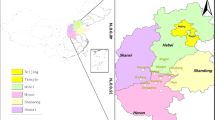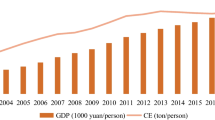Abstract
Based on the 2015 transportation CO2 emissions and economic and social data for the 286 cities in China, exploratory spatial data analysis (ESDA) method and a geographically weighted regression (GWR) model were used to analyze the spatial distribution characteristics of transportation CO2 emissions and their influencing factors. The results showed that the CO2 emissions from urban transportation in China featured significant spatial agglomeration. The high emission areas were mainly concentrated in Beijing, Shanghai, Chongqing, Chengdu, Nanjing, and other regional core cities, while the low emission areas were mainly concentrated in the cities of Gansu, Guizhou, Yunnan, and other underdeveloped provinces. Considering the overall evolution of the factors affecting transportation CO2 emissions, private car ownership, technological innovation, and industrial structure correlated positively with transportation CO2 emissions. Population density, urbanization rate, per capita urban road area, and transportation structure could significantly inhibit transportation CO2 emissions. The impact of per capita GDP, public transportation, and environmental regulation on transportation CO2 emissions was insignificant. From the perspective of spatial heterogeneity, there were significant regional differences in the impact of various factors on CO2 emissions. Private car ownership, technological innovation capacity, and per capita GDP all had a positive impact on transportation CO2 emissions. Urbanization rate, urban road area per capita, and transportation structure all had a negative impact on transportation CO2 emissions. Population density, industrial structure, public transportation, and environmental regulation all had a two-way impact on transportation CO2 emissions in different cities.





Similar content being viewed by others
References
Abdull N, Yoneda M, Shimada Y (2020) Traffic characteristics and pollutant emission from road transport in urban area. Air Qual Atmos Health
Ahmed Z, Wang ZH, Ali S (2019) Investigating the non-linear relationship between urbanization and CO2 emissions: an empirical analysis. Air Qual Atmos Health 12:945–953
Asian Development Bank (2019) Addressing climate change in transport. https://www.adb.org/sectors/transport/key-priorities/climate-change/. Accessed 1 Feb 2020
Bai CQ, Zhou L, Xia ML, Feng C (2020) Analysis of the spatial association network structure of China’s transportation carbon emissions and its driving factors. J Environ Manag 253:109765
Bastani P, Heywood JB, Hope C (2012) The effect of uncertainty on US transport-related GHG emissions and fuel consumption out to 2050. Transp Res A-POL 46:517–548
Cai BF, Yang WS, Cao D, Liu LC, Zhou Y, Zhang ZS (2012) Estimates of China’s national and regional transport sector CO2 emissions in 2007. Energy Policy 41:74–483
Cai B, Guo H, Cao L, Guan D, Bai H (2018) Local strategies for China’s carbon mitigation: an investigation of Chinese city-level CO2 emissions. J Clean Prod 178:890–902
Chang CC, Chung CL (2018) Greenhouse gas mitigation policies in Taiwan’s road transportation sectors. Energy Policy 123:299–307
Elhorst JP (2012) Matlab software for spatial panels. Int Reg Sci Rev 37:389–405
Ercan T, Onat NC, Tatari O (2016) Investigating carbon footprint reduction potential of public transportation in United States: a system dynamics approach. J Clean Prod 133:1260–1276
Feng C, Huang J, Wang M (2019) The sustainability of China’s metal industries: features, challenges and future focuses. Resour Policy 60:215–224
Han X, Xu Y, Kumar A, Lu X (2018) Decoupling analysis of transportation carbon emissions and economic growth in China. Environ Prog Sustain Energy 37:1696–1704
Huang J, Luo Y, Feng C (2019) An overview of carbon dioxide emissions from China’s ferrous metal industry: 1991-2030. Resour Policy 62:541–549
International Energy Agency (2018) CO2 emissions from fuel combustion. https://webstore.iea.org/co2-emissions-from-fuel-combustion-2018-highlights. Accessed 9 Feb 2020
Liu Y, Feng C (2020) Decouple transport CO2 emissions from China’s economic expansion: a temporal-spatial analysis. Transp Res D-TR E 79:102225
Liu X, Ma SF, Tian JF, Jia N, Li G (2015) System dynamics approach to scenario analysis for urban passenger transport energy consumption and CO2 emissions: a case study of Beijing. Energy Policy 85:253–270
Liu YS, Yan B, Zhou Y (2016) Urbanization, economic growth, and carbon dioxide emissions in China: a panel cointegration and causality analysis. J Geogr Sci 26:131–152
Lu S, Jiang H, Liu Y, Huang S (2017) Regional disparities and influencing factors of average CO2 emissions from transportation industry in Yangtze River Economic Belt. Transp Res D-TR E 57:112–123
Lv Q, Liu HB, Yang DY, Liu H (2019) Effects of urbanization on freight transport carbon emissions in China: common characteristics and regional disparity. J Clean Prod 211:481–489
Nocera S, Galati OI, Cavallaro F (2018a) On the uncertainty in the economic valuation of carbon emissions from transport. J Transp Econ Policy 52:68–94
Nocera S, Ruiz-Alarcón-Quintero C, Cavallaro F (2018b) Assessing carbon emissions from road transport through traffic flow estimators. Transp Res C-EMER 95:125–148
Pei Y, Zhu YM, Liu SX, Wang XC, Cao JJ (2019) Environmental regulation and carbon emission: the mediation effect of technical efficiency. J Clean Prod 236:117599
Qin HT, Huang QH, Zhang ZW, Lu Y, Li MC, Xu L, Chen ZJ (2019) Carbon dioxide emission driving factors analysis and policy implications of Chinese cities: combining geographically weighted regression with two-step cluster. Sci Total Environ 684:413–424
Shen J, Wei YD, Yang Z (2017) The impact of environmental regulations on the location of pollution-intensive industries in China. J Clean Prod 148:785–794
Wang M, Feng C (2019) Decoupling economic growth from carbon dioxide emissions in China’s metal industrial sectors: a technological and efficiency perspective. Sci Total Environ 691:1173–1181
Wang X, Lin B (2016) How to reduce CO2 emissions in China’s iron and steel industry. Renew Sust Energ Rev 57:1496–1505
Wang H, Ou X, Zhang X (2017) Mode, technology, energy consumption, and resulting CO2 emissions in China’s transport sector up to 2050. Energy Policy 109:719–733
Wu LF, Xu ZC (2019) Analyzing the air quality of Beijing, Tianjin, and Shijiazhuang using grey Verhulst model. Air Qual Atmos Health 12:1419–1426
Wu D, Yuan C, Liu H (2018) The decoupling states of CO2 emissions in the Chinese transport sector from 1994 to 2012: a perspective on fuel types. Energy Environ 29:591–612
Yang L, Wang YQ, Han SS, Liu YY (2019) Urban transport carbon dioxide (CO2) emissions by commuters in rapidly-developing cities: the comparative study of Beijing and Xi’an in China. Transp Res D-TR E 68:65–83
Yang L, Wang YQ, Lian YJ, Han SS (2020) Factors and scenario analysis of transport carbon dioxide emissions in rapidly-developing cities. Transp Res D-TR E 80:102252
Zhao X, Yin H (2011) Industrial relocation and energy consumption: evidence from China. Energy Policy 39:2944–2956
Funding
This work was supported by the National Natural Science Foundation of China for Young Scholars (No. 71603202), the Shaanxi Soft Science Foundation (No. 2019KRM129), the Shaanxi Province Education Department Philosophy and Social Science Key Institute Base Project (No. 19JZ048), the Xi’an Social Science Planning Fund Project (No. 19J13), the Xi’an Soft Science Foundation (No. 2019111813RKX002SF006-6), and the Scientific Research Project of China (Xi’an) Institute for Silk Road Research (No. 2019YA08).
Author information
Authors and Affiliations
Corresponding author
Additional information
Publisher’s note
Springer Nature remains neutral with regard to jurisdictional claims in published maps and institutional affiliations.
Rights and permissions
About this article
Cite this article
Wang, H., Zhang, X. Spatial heterogeneity of factors influencing transportation CO2 emissions in Chinese cities: based on geographically weighted regression model. Air Qual Atmos Health 13, 977–989 (2020). https://doi.org/10.1007/s11869-020-00854-2
Received:
Accepted:
Published:
Issue Date:
DOI: https://doi.org/10.1007/s11869-020-00854-2




